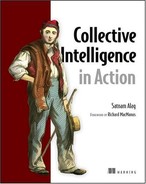Foreword
When I founded ReadWriteWeb[1] back in April 2003, a tech news and analysis blog that is now one of the world’s top 10 blogs,[2] my goal was to explore the current era of the web. The year 2003 was a time when the effects of the dot-com meltdown were still being felt, yet there was something new stirring on the web, too. I christened my new blog Read/Write Web (the slash and space have since been dropped) because this new era of the web seemed to embody the notion that Tim Berners-Lee had when he invented the web—that it ought to be editable by anyone and that everyone contributes in some way to the web’s data.
2 According to Technorati http://www.technorati.com/pop/blogs/
As Satnam Alag writes in this book, collective intelligence as a research field actually predates the web. But it was after the dot-com era had ended that we began to see evidence of collective intelligence applied to the web. In 2003 we regularly saw it in sites like Amazon, with its user reviews and recommendations, eBay with its user-driven auctions, Wikipedia with its editable encyclopedia, and Google with its mysterious PageRank algorithm for ranking the popularity of web pages.
Sometime in 2004, O’Reilly & Associates coined the term Web 2.0, which eventually gained mainstream acceptance as the term for this era of the web (just as dot-com described the previous one). A central part of the new definition was the notion of harnessing collective intelligence, in which user contributions could be valuable in aggregate if mined and utilized in some way in your web site or application.
For all the popularity of Web 2.0, it remains difficult to implement many of its principles. This is where this book comes in, because it applies mathematical formulas and examples to the notion of collective intelligence (from now on simply known as CI). After explaining how to gather data and extract intelligence on the web, in part 2 of the book Satnam instructs you on specific CI techniques such as data mining, text analysis, clustering, and predictive technology.
And, pssst, do you want to know how to build a recommendation engine? This is an area of web technology that we at ReadWriteWeb have been covering with great interest in 2008. Recommendation engines, as Satnam notes, aim to show items of interest to a user. But in our reviews of the current wave of recommendation engines, we have seen that it’s hard—very hard—to get recommendations right. Satnam shows how the leading practitioners, such as Amazon, Google News, and Netflix, build their recommendation engines. He also explains the different approaches you can take, with examples that developers can use and deploy in their own applications.
The Read/Write Web, or Web 2.0, or the Social Web, whatever you want to call it, relies on and builds value from user participation. If you’re a web developer, you’ll want to know how to use CI techniques to ensure that your web application can extract valuable data from its usage—and most importantly deliver that value right back to the users, where it belongs. This book goes a long way towards explaining how to do this.
RICHARD MACMANUS
FOUNDER/EDITOR, READWRITEWEB
